This natural conditioner bar recipe has been a long time coming. After all, my natural shampoo bar recipes have been popular for many years now.
I now have this recipe below, plus another that’s more formulated for all hair types here: Natural Conditioner Bar for All Hair Types
I’ve been very happy with using a diluted apple cider vinegar spray as a conditioner for many years (add a little lavender and vanilla essential oil and it smells wonderful). But recently I was traveling and realized it would be a lot more convenient if I didn’t have to worry about a bottle leaking. Plus, a conditioner bar would take up a lot less space.
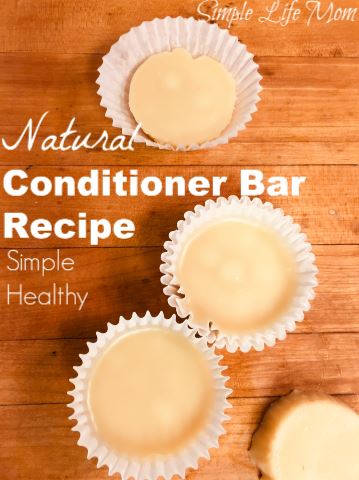
Why A Conditioner Bar Recipe?
As I just mentioned, having a conditioner bar can be very handy when traveling. But there are a lot more benefits:
- Conditioner bars are frugal – a small bar lasts a month or more and once you’ve gathered the ingredients you can make a number of bars for yourself and your family.
- They travel easily. They dry quickly and make traveling simple with no worry about spills.
- They are healthy. If you make sure you know and understand each ingredient, then you know you are using something that will nourish your hair and scalp, not just make your hair look nice.
You can buy shampoo bars and conditioner spray in my shop
Safety Precautions
Most recipes that you will find for conditioner bar recipes have Behentrimonium Methosulfate, which is an ammonium salt made from Rapeseed oil. It’s generally considered safe, but no one can point to any research that states that it is good for skin or hair.
I feel like the research is lacking too much, so this is one ingredient I’d like to skip.
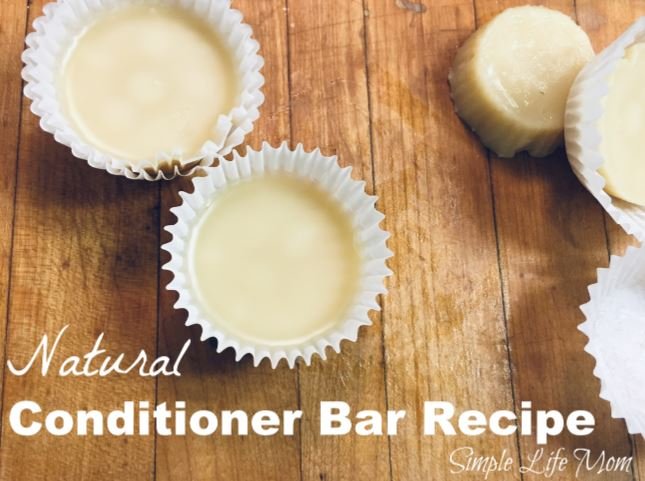
Creating the Best Conditioner Bar Recipe
I really had to start from scratch to create these conditioning bars. There’s a lot that goes into a really good conditioner bar. I had to do a lot of research and a lot of experiments. And there’s a lot that I want in a bar.
I want it to have only nourishing ingredients, nothing questionable.
I want it to have the right pH.
Shampoo bars are slightly alkaline, so you want ingredients that will be slightly acidic. For example, cocoa butter is slightly acidic, so it pairs well with other slightly acidic ingredients like shea butter and bees wax.
Oils don’t have a pH, so in choosing oils I needed to look at oils that are beneficial to sealing and nourishing the hair shaft like jojoba, argon, coconut, and avocado oils.
I also want it to have the right hardness. It needs to dry nicely, stay hard, but not be too hard where it doesn’t lather and spread well.
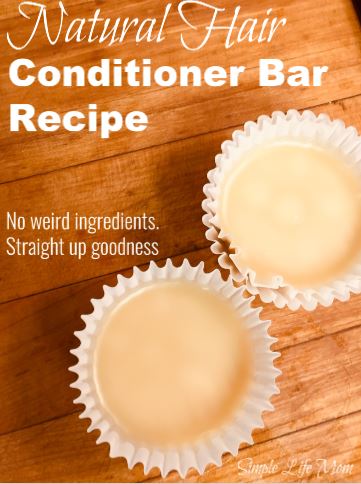
How to Use
This is VERY important! A few of you have mentioned how your hair feels greasy after using these conditioner bars. You are using way too much.
These are oil based conditioner bars that should last months. They are designed to condition and moisturize at the same time. You put only a little onto your hands and start by working into the ends of your hair and then rubbing hands throughout the rest of your hair. This will keep most of the oils at the ends of your hair where it is needed, but will also condition the rest of your hair.
Put your head under warm/hot water and work hands through hair to distribute. This works wonderfully on my thick, curly hair. If your hair is thin or tends to be greasy, you may have a better experience using an herbal hair rinse.
Conditioner Bar Recipe
Conditioner Bar Recipe
Equipment
- 1 whisk
- 1 12 cup muffin tin , or small soap mold
Ingredients
- 3 tablespoons shea butter
- 2 tablespoons Beeswax
- 2 tablespoons cocoa butter
- 2 tablespoons Coconut Oil
- 2 tablespoons mango butter
- 1 teaspoon argon oil
- 1 teaspoon avocado oil
- 30 drops Lavender Essential Oil – or other essential oil of choice
Instructions
- Combine all ingredients, except essential oil, in a double boiler. I like to use a glass measuring cup in a saucepan of boiling water.3 tablespoons shea butter, 2 tablespoons Beeswax, 2 tablespoons cocoa butter, 2 tablespoons Coconut Oil, 2 tablespoons mango butter, 1 teaspoon argon oil, 1 teaspoon avocado oil
- Stir on and off until melted.
- Remove from heat and add essential oil. Stir.30 drops Lavender Essential Oil
- Pour into molds (makes 4 one ounce bars). If you don't have a mold, use muffin liners in muffin cups until cooled and hardened.
This recipe makes four 1-ounce bars.
You will combine all ingredients, except the essential oil, in a double boiler. I like to use a glass measuring cup in a saucepan of boiling water. Stir on and off until melted.
Remove from heat and then add the essential oil of your choice and stir until well combined.
Pour into molds (makes 4 one ounce bars). If you don’t have a mold, use muffin liners in muffin cups until cooled and hardened.
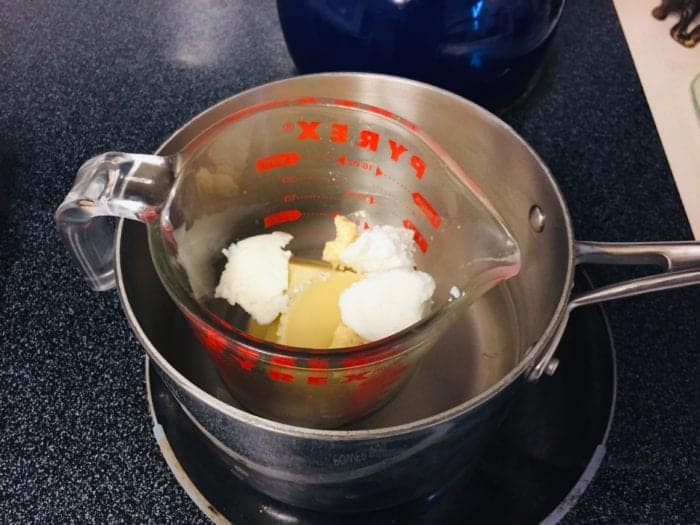
How to Use Condition Bars
After washing and rinsing your hair with a shampoo bar, rub conditioner bar between your hands to get a light layer on both hands.
Spread into your hair, taking care to avoid hair around your face (because that hair usually becomes oils first) until last.
Using warm to hot water, rinse your hair. This will make sure it spreads throughout your hair and the hot water will insure it is spread evenly.
Towel dry, brush, and you’re ready to go!
As I said above, I also now have a conditioner bar that is formulated more for all hair types here: Natural Conditioner Bar for All Hair Types
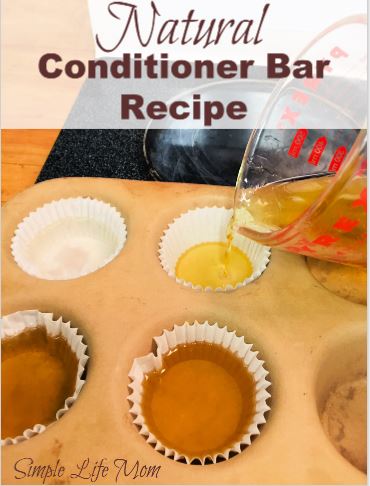


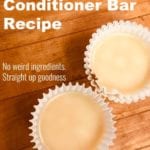
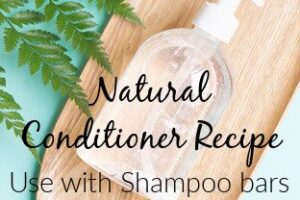

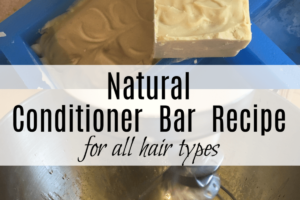





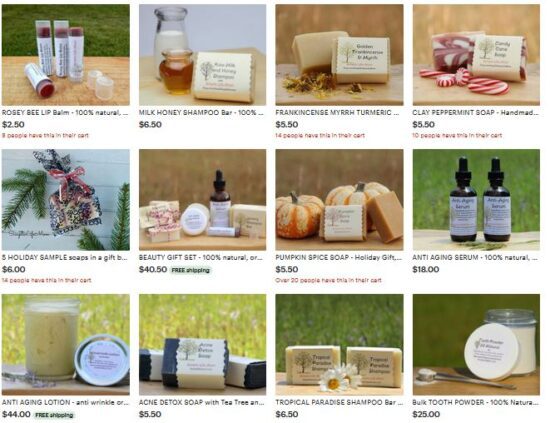
324 Comments
Leave your reply.